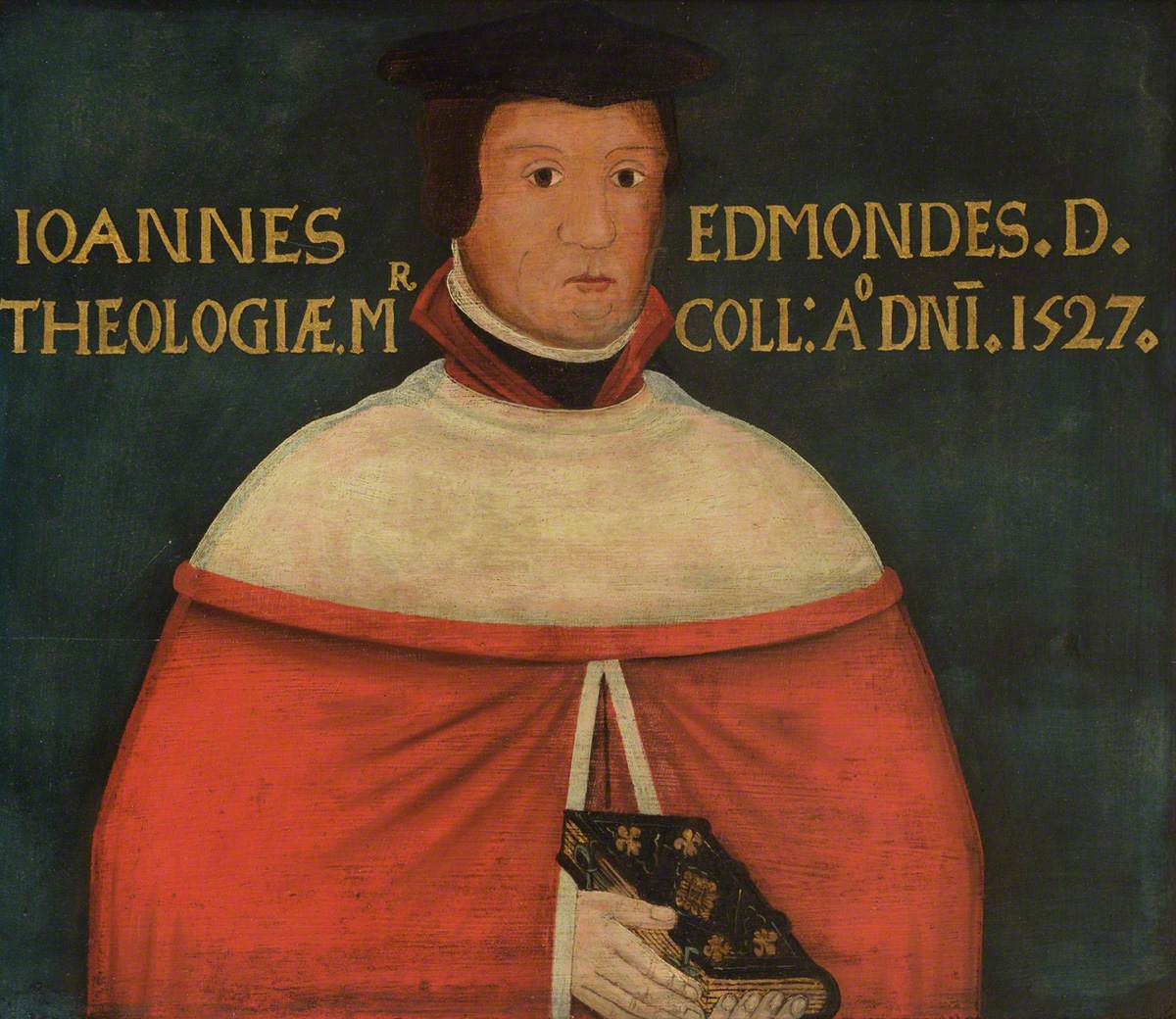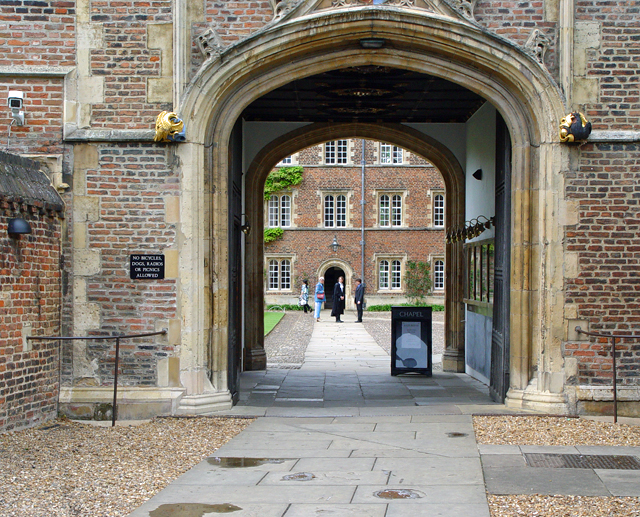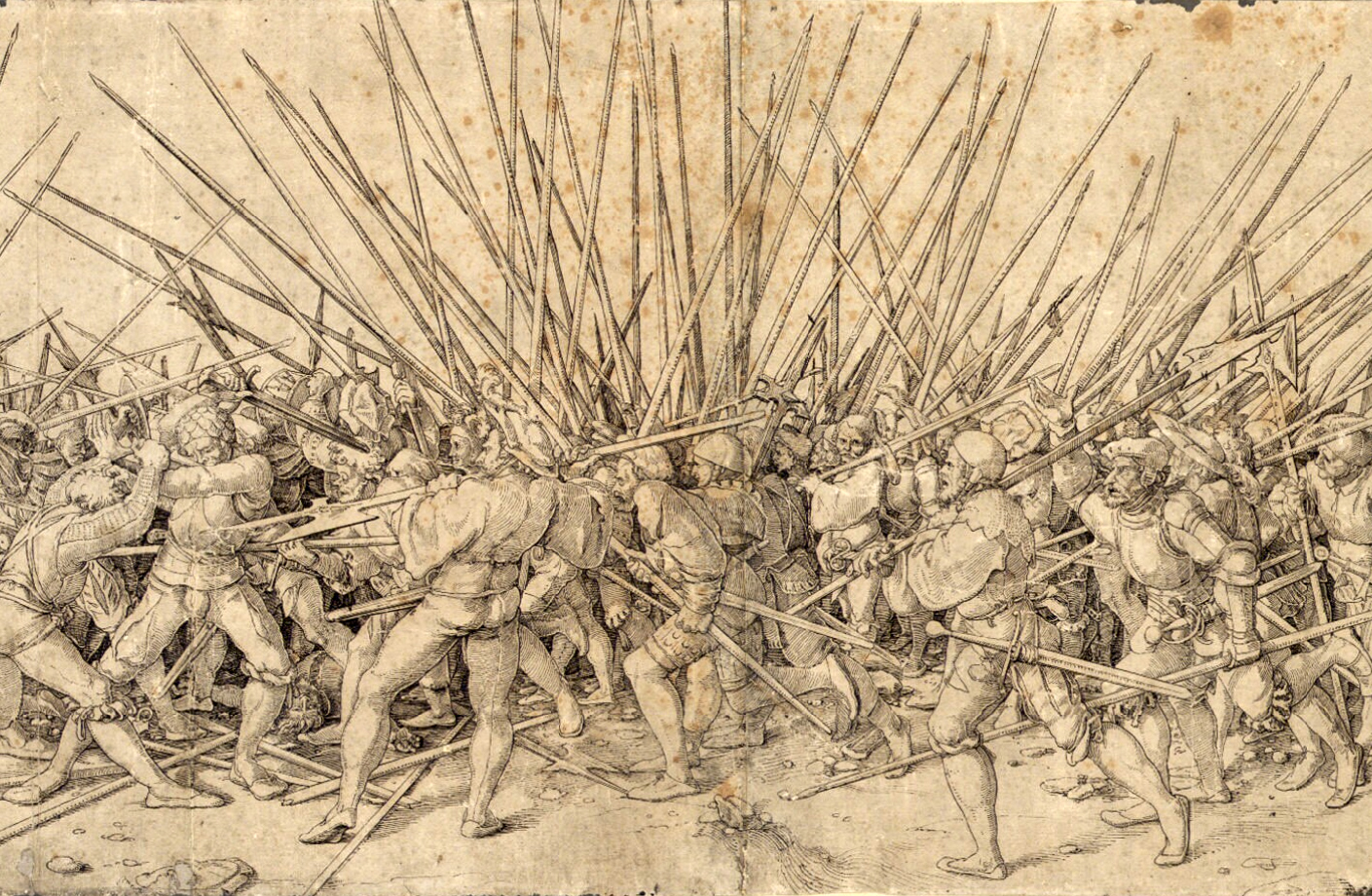|
John Edmunds (academic)
John Edmunds (died 1544) was master of Peterhouse, Cambridge. Edmunds proceeded B.A. 1503–4, M.A. 1507, was admitted fellow of Jesus College, Cambridge, 1517, and afterwards fellow of St. John's 1519. He was prebendary of St. Paul's Cathedral 1510–17, and chancellor 1517–29. He commenced D.D. 1520, being then a member of Peterhouse; was Lady Margaret preacher 1521, was elected master of Peterhouse 1522, vice-chancellor 1523–8–9, 1541–3, and became chancellor of Salisbury Cathedral. He also held a prebend in the same church. He died in November 1544 and was buried in the Church of St. Mary, outside Trumpington gates. He married a sister of the wife of John Mere. He was one of the compilers of ‘The Institution of a Christian Man The Thirty-nine Articles of Religion (commonly abbreviated as the Thirty-nine Articles or the XXXIX Articles) are the historically defining statements of doctrines and practices of the Church of England with respect to the controve ... [...More Info...] [...Related Items...] OR: [Wikipedia] [Google] [Baidu] |
John Edmunds Peterhouse
John is a common English name and surname: * John (given name) * John (surname) John may also refer to: New Testament Works * Gospel of John, a title often shortened to John * First Epistle of John, often shortened to 1 John * Second Epistle of John, often shortened to 2 John * Third Epistle of John, often shortened to 3 John People * John the Baptist (died c. AD 30), regarded as a prophet and the forerunner of Jesus Christ * John the Apostle (lived c. AD 30), one of the twelve apostles of Jesus * John the Evangelist, assigned author of the Fourth Gospel, once identified with the Apostle * John of Patmos, also known as John the Divine or John the Revelator, the author of the Book of Revelation, once identified with the Apostle * John the Presbyter, a figure either identified with or distinguished from the Apostle, the Evangelist and John of Patmos Other people with the given name Religious figures * John, father of Andrew the Apostle and Saint Peter * Pope J ... [...More Info...] [...Related Items...] OR: [Wikipedia] [Google] [Baidu] |
Peterhouse, Cambridge
Peterhouse is the oldest constituent college of the University of Cambridge in England, founded in 1284 by Hugh de Balsham, Bishop of Ely. Today, Peterhouse has 254 undergraduates, 116 full-time graduate students and 54 fellows. It is quite often erroneously referred to as ''Peterhouse College'', although the correct name is simply ''Peterhouse''. Peterhouse alumni are notably eminent within the natural sciences, including scientists Lord Kelvin, Henry Cavendish, Charles Babbage, James Clerk Maxwell, James Dewar, Frank Whittle, and five Nobel prize winners in science: Sir John Kendrew, Sir Aaron Klug, Archer Martin, Max Perutz, and Michael Levitt. Peterhouse alumni also include the Archbishop of Canterbury John Whitgift, Lord Chancellors, Lord Chief Justices, as well as Oscar-winning film director Sam Mendes, and comedian David Mitchell. British Prime Minister Augustus FitzRoy, 3rd Duke of Grafton, and Elijah Mudenda, second prime minister of Zambia, also studied at t ... [...More Info...] [...Related Items...] OR: [Wikipedia] [Google] [Baidu] |
Jesus College, Cambridge
Jesus College is a constituent college of the University of Cambridge. The college's full name is The College of the Blessed Virgin Mary, Saint John the Evangelist and the glorious Virgin Saint Radegund, near Cambridge. Its common name comes from the name of its chapel, Jesus Chapel. Jesus College was established in 1496 on the site of the twelfth-century Benedictine nunnery of St Mary and St Radegund by John Alcock, then Bishop of Ely. The cockerel is the symbol of Jesus College, after the surname of its founder. For the 300 years from 1560 to 1860, Jesus College was primarily a training college for Church of England clergy. Jesus College has assets of approximately £344m making it Cambridge's fourth-wealthiest college. The college is known for its particularly expansive grounds which include its sporting fields and for its close proximity to its boathouse. Three members of Jesus College have received a Nobel Prize. Two fellows of the college have been appointed to the I ... [...More Info...] [...Related Items...] OR: [Wikipedia] [Google] [Baidu] |
Lady Margaret Preacher
The word ''lady'' is a term for a girl or woman, with various connotations. Once used to describe only women of a high social class or status, the equivalent of lord, now it may refer to any adult woman, as gentleman can be used for men. Informal use is sometimes euphemistic ("lady of the night" for prostitute) or, in American slang, condescending in direct address (equivalent to "mister" or "man"). "Lady" is also a formal title in the United Kingdom. "Lady" is used before the family name of a woman with a title of nobility or honorary title ''suo jure'' (in her own right), or the wife of a lord, a baronet, Scottish feudal baron, laird, or a knight, and also before the first name of the daughter of a duke, marquess, or earl. Etymology The word comes from Old English '; the first part of the word is a mutated form of ', "loaf, bread", also seen in the corresponding ', "lord". The second part is usually taken to be from the root ''dig-'', "to knead", seen also in dough; ... [...More Info...] [...Related Items...] OR: [Wikipedia] [Google] [Baidu] |
Salisbury Cathedral
Salisbury Cathedral, formally the Cathedral Church of the Blessed Virgin Mary, is an Anglican cathedral in Salisbury, England. The cathedral is the mother church of the Diocese of Salisbury and is the seat of the Bishop of Salisbury. The building is regarded as one of the leading examples of Early English Gothic architecture. Its main body was completed in 38 years, from 1220 to 1258. The spire, built in 1320, at , has been the tallest church spire in the United Kingdom since 1561. Visitors can take the "Tower Tour", in which the interior of the hollow spire, with its ancient wooden scaffolding, can be viewed. The cathedral has the largest cloister and the largest cathedral close in Britain at . It contains a clock which is among the oldest working examples in the world, and has one of the four surviving original copies of ''Magna Carta''. In 2008, the cathedral celebrated the 750th anniversary of its consecration. History As a response to deteriorating relations between ... [...More Info...] [...Related Items...] OR: [Wikipedia] [Google] [Baidu] |
Little St Mary's, Cambridge
Little St Mary's or St Mary the Less is a Church of England parish church in Cambridge, England, on Trumpington Street between Pembroke College's Mill Lane Project development site and Peterhouse. The church Is in the Diocese of Ely and follows the 'Anglo-Catholic' or 'high-church' tradition of the Church of England. In addition to its main Sunday Mass, the church has a strong tradition of daily morning and evening prayer, regular weekday Communion and the keeping of church festivals. The church has a particular ministry helping men and women to explore possible vocations to the priesthood. Little St Mary's has active overseas mission links, provides support to local mental health projects, and participates in Hope Cambridge's Churches Homeless Project. At present, the vicar is The Rev. Dr Robert Mackley. History There has been a place of worship on the current site since around the twelfth century. The earliest known records of the church state that the first churc ... [...More Info...] [...Related Items...] OR: [Wikipedia] [Google] [Baidu] |
The Institution Of A Christian Man
The Thirty-nine Articles of Religion (commonly abbreviated as the Thirty-nine Articles or the XXXIX Articles) are the historically defining statements of doctrines and practices of the Church of England with respect to the controversies of the English Reformation. The Thirty-nine Articles form part of the ''Book of Common Prayer'' used by the Church of England, the U.S. Episcopal Church, and the Anglican Church in North America among other denominations in the worldwide Anglican Communion and Anglican Continuum. When Henry VIII broke with the Roman Catholic Church and was excommunicated, he began the reform of the Church of England, which would be headed by the monarch (himself), rather than the pope. At this point, he needed to determine what its doctrines and practices would be in relation to the Church of Rome and the new Protestant movements in continental Europe. A series of defining documents were written and replaced over a period of thirty years as the doctrinal and ... [...More Info...] [...Related Items...] OR: [Wikipedia] [Google] [Baidu] |
Year Of Birth Missing
A year or annus is the orbital period of a planetary body, for example, the Earth, moving in its orbit around the Sun. Due to the Earth's axial tilt, the course of a year sees the passing of the seasons, marked by change in weather, the hours of daylight, and, consequently, vegetation and soil fertility. In temperate and subpolar regions around the planet, four seasons are generally recognized: spring, summer, autumn and winter. In tropical and subtropical regions, several geographical sectors do not present defined seasons; but in the seasonal tropics, the annual wet and dry seasons are recognized and tracked. A calendar year is an approximation of the number of days of the Earth's orbital period, as counted in a given calendar. The Gregorian calendar, or modern calendar, presents its calendar year to be either a common year of 365 days or a leap year of 366 days, as do the Julian calendars. For the Gregorian calendar, the average length of the calendar year (the mea ... [...More Info...] [...Related Items...] OR: [Wikipedia] [Google] [Baidu] |
1544 Deaths
__NOTOC__ Events January–June * January 13 – At Västerås, the estates of Sweden swear loyalty to King Gustav Vasa and to his heirs, ending the traditional electoral monarchy in Sweden. Gustav subsequently signs an alliance with the Kingdom of France. * February 20 – The Fourth Diet of Speyer is convened. * April 11 – Battle of Ceresole: French forces under the Comte d'Enghien defeat forces of the Holy Roman Empire, under the Marques Del Vasto, near Turin. * May – Charles V, Holy Roman Emperor, again invades eastern France. * May 3 – Edward Seymour, Earl of Hertford, with an English army, captures Leith and Edinburgh from the Kingdom of Scotland. * June 19–August 18 – Troops of the Holy Roman Empire besiege Saint-Dizier, in eastern France. July–December * July – Battle of the Shirts: The Clan Fraser of Lovat and Macdonalds of Clan Ranald fight over a disputed chiefship in Scotland; reportedly, five Fras ... [...More Info...] [...Related Items...] OR: [Wikipedia] [Google] [Baidu] |
16th-century English Educators
The 16th century begins with the Julian year 1501 ( MDI) and ends with either the Julian or the Gregorian year 1600 ( MDC) (depending on the reckoning used; the Gregorian calendar introduced a lapse of 10 days in October 1582). The 16th century is regarded by historians as the century which saw the rise of Western civilization and the Islamic gunpowder empires. The Renaissance in Italy and Europe saw the emergence of important artists, authors and scientists, and led to the foundation of important subjects which include accounting and political science. Copernicus proposed the heliocentric universe, which was met with strong resistance, and Tycho Brahe refuted the theory of celestial spheres through observational measurement of the 1572 appearance of a Milky Way supernova. These events directly challenged the long-held notion of an immutable universe supported by Ptolemy and Aristotle, and led to major revolutions in astronomy and science. Galileo Galilei became a champion o ... [...More Info...] [...Related Items...] OR: [Wikipedia] [Google] [Baidu] |








